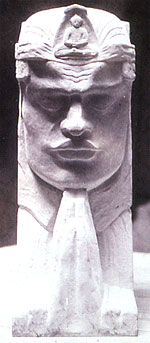John & Katharine Maltwood Collection
| View the Collection |
History of the Collection |
John & Katharine Maltwood |
Information Resources |
The Maltwoods Introduction
Katharine Maltwood Biography
Early Sculpture Post-War Works
- War and Travel - Religious Mysticism - Philosophical Leanings - Style and Outlook - Egyptian Influence - Studio at Kensington - House of Fulfillment - Lily Adams Beck Glastonbury Zodiac Life in Victoria, B.C. Monograph (pdf 1.14 MB)
About Us Contact Us Visit Us Site Map

Post-War Works - Part 5: Egyptian Influence | ||||||
The artist's study of Egyptology and the new mystic character in her work appears in an alabaster group Infinity which she also entitled Isis, Horus and Osiris. Here she combines Egyptian characteristics with a Western feeling for planes and angles and a strict adherence to the block. In subject matter it refers to the myth of Osiris, the Egyptian God of the Dead, who represents moral good and fights for the welfare of the human soul. Osiris is killed by his opponent Seth and, watched by his consort Isis, revives in another form to urge his son Horus to avenge him. With the aid of Thoth or reason Horns destroys the evil power of Seth. The myth is a picture of the daily life of the sun combating darkness yet at last succumbing to it, to appear again in renewed splendour, as the young Horns, a solar god triumphs over Seth. It appealed to Katharine Maltwood because it is also a picture of human life, the perpetual struggles and conflicts and final seeming destruction, to be restored in the new youth of a brighter existence. This view agrees with her Eastern outlook that suffering is not wholly evil but has its beneficient aspect in the accomplishment of final perfection.
In 1920 the Caryatid, Priest of Buddha, was exhibited at the London Salon after being rejected by the Royal Academy. Being carved directly in Portland stone without a preparatory model it met with more approval among art critics. The piece was admired as having "great dignity and grandeur" and for expounding "in one massive head the religion of Buddha". The peaceful pose of meditation and the atmosphere of deep harmony are characteristics Katharine Maltwood sought to express in much of her sculpture from these years. The Spirits of Just Men Made Perfect has like Priest of Buddha apparently not survived. A mystical and fantastic conception it shows the souls of those who strive for perfection, lifted one by one, high in the hands of a great angel and growing smaller as they approach ultimate union with the Almighty. One of the most interesting works remaining from this period is an alabaster figure entitled Archangel or The Holy Grail. In 1922 a plaster model with gilt was exhibited at the Daily Express Women's exhibition and the following year the completed alabaster version was shown at the Royal Academy. Press reports mention that it was designed for colossal reproduction as the roof-supporting, external pillars of a domed cathedral. The effect is of solid strength and continuity of material with concern for architectural function.
The title The Holy Grail refers to her interest in Arthurian legends where she believed the cup symbolized the vault of heaven inserted on earth. She felt it embodied the lost knowledge man must rediscover to achieve spiritual salvation. The work was also referred to as Dweller in the Innermost and Samadhi. The latter refers to the name given in Yoga to the state of perfection reached when one's mind is completely restrained from mental activity and is situated in a state of transcendental happiness. Which title she preferred is unclear, however they all reveal her interest in conveying a spiritual message to the beholder. It is interesting that several critics took objection to the figure on the grounds that it "might have been improved ...by a less staunch adherence to motives from Maya art." The artist strongly objected to these accusations and in a letter to Drawing in July 1923 says "Don't you think it's a kind of cosmic consciousness that works through all races getting more or less the same results? For I am convinced that whatever influences may have shaped my work, Maya has not." A more likely source of inspiration is Egyptian art since Katharine Maltwood had recently made two trips through Egypt. The colossal roof supporting figures in the temple of Abu Simbel, which she photographed, come to mind. Further evidence of Egyptian influence is suggested by a preparatory pencil sketch of the Holy Grail drawn on one of the Maltwood books on Egyptian art.36
All content on this page is copyright © 30 January, 2006 |
||||||


